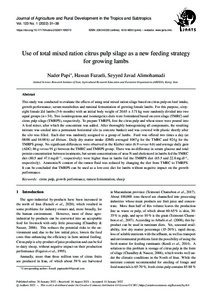Use of total mixed ration citrus pulp silage as a new feeding strategy for growing lambs
| dc.date.accessioned | 2022-01-27T11:31:19Z | |
| dc.date.available | 2022-01-27T11:31:19Z | |
| dc.date.issued | 2022-01-26 | |
| dc.identifier | doi:10.17170/kobra-202201195570 | |
| dc.identifier.uri | http://hdl.handle.net/123456789/13556 | |
| dc.language.iso | eng | eng |
| dc.rights | Namensnennung 4.0 International | * |
| dc.rights.uri | http://creativecommons.org/licenses/by/4.0/ | * |
| dc.subject | citrus pulp | eng |
| dc.subject | growth performance | eng |
| dc.subject | rumen fermentation | eng |
| dc.subject | sheep | eng |
| dc.subject.ddc | 630 | |
| dc.title | Use of total mixed ration citrus pulp silage as a new feeding strategy for growing lambs | eng |
| dc.type | Aufsatz | |
| dcterms.abstract | This study was conducted to evaluate the effects of using total mixed ration silage based on citrus pulp on feed intake, growth performance, serum metabolites and ruminal fermentation of growing female lambs. For this purpose, sixty-eight female Zel lambs (5-6-months) with an initial body weight of 20.65 ± 3.71 kg were randomly divided into two equal groups (n=34). Two isonitrogenous and isoenergetics diets were formulated based on corn silage (TMRC) and citrus pulp silage (TMRPS), respectively. To prepare TMRPS, first the citrus pulp and wheat straw were poured into A feed mixer, after which the concentrate was added. After thoroughly homogenising all components, the resulting mixture was ensiled into a permanent horizontal silo (a concrete bunker) and was covered with plastic shortly after the silo was filled. Each diet was randomly assigned to a group of lambs. Feed was offered two times a day (at 08:00 and 16:00 h) ad libitum. Daily dry matter intake (DMI) averaged 1067 g for the TMRC and 924 g for the TMRPS group. No significant differences were observed in the Kleiber ratio (6.9 versus 6.6) and average daily gain (ADG; 86 g versus 91 g) between the TMRC and TMRPS group. There was no difference in serum glucose and total protein concentration between treatments, but serum concentrations of urea-N and cholesterol in lambs fed the TMRC diet (80.5 and 47.1 mg/dl, respectively) were higher than in lambs fed the TMRPS diet (65.5 and 22.8 mg/dl, respectively). Ammonia-N content of the rumen fluid was reduced by changing the diet from TMRC to TMRPS. It can be concluded that TMRPS can be used as a low-cost diet for lambs without negative impact on the growth performance. | eng |
| dcterms.accessRights | open access | |
| dcterms.creator | Papi, Nader | |
| dcterms.creator | Fazaeli, Hassan | |
| dcterms.creator | Alimohamadi, Seyyed Javad | |
| dc.subject.swd | Lämmeraufzucht | ger |
| dc.subject.swd | Fütterung | ger |
| dc.subject.swd | Mischfutter | ger |
| dc.subject.swd | Zitrusprodukt | ger |
| dc.subject.swd | Wachstum | ger |
| dc.subject.swd | Pansen | ger |
| dc.subject.swd | Fermentation | ger |
| dc.type.version | publishedVersion | |
| dcterms.source.identifier | eissn:2363-6033 | |
| dcterms.source.issue | No. 1 | |
| dcterms.source.journal | Journal of Agriculture and Rural Development in the Tropics and Subtropics (JARTS) | eng |
| dcterms.source.pageinfo | 31-38 | |
| dcterms.source.volume | Vol. 123 | |
| kup.iskup | false |
Dateien zu dieser Ressource
Das Dokument erscheint in:
-
Vol 123, No 1 (2022) [14]


